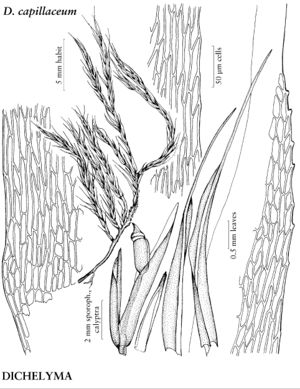Dichelyma
Kongl. Vetensk. Acad. Handl. 1832: 273, plates 6, 7. 1833.
| Taxon | Illustrator ⠉ | |
|---|---|---|
 | Dichelyma capillaceum | Patricia M. Eckel |
Plants small to large, glossy. Stems prostrate or pendent; rhizoids from initials abaxial to leaf insertions, not or irregularly branched; axillary hairs 100–300 µm. Leaves distant or crowded, lanceolate to linear-lanceolate, keeled, conduplicate; margins plane or very narrowly recurved, entire or obscurely serrulate proximally, serrulate distally; apex obtuse, acute, or filiform-acuminate; costa subpercurrent to long-excurrent; alar cells quadrate or rectangular, not or slightly enlarged, walls firm; medial laminal cells linear to linear-rhomboidal. Perigonia lateral in leaf-axils. Perichaetia with leaves elongate, sheathing setae. Seta 3–15 (–20) mm. Capsule immersed, laterally emergent, emergent, or exserted, oval, oval-oblong, subcylindric, or cylindric; annulus rudimentary; operculum conic or obliquely long-rostrate; endostome trellis imperfect or perfect. Calyptra long-cucullate, covering capsule and often clasping base of seta when young. Spores 10–17 µm.
Distribution
North America, Europe, Asia
Discussion
Species 5 (4 in the flora).
Dichelyma is often considered an aquatic moss, but is semi-aquatic. Distinctive gametophytic features include long, narrow, keeled-conduplicate leaves with strong, single costae and weakly developed, not or scarcely bulging alar cells. The keeled-conduplicate leaves lie flat on one side when placed on a microscope slide and so when measuring leaf width it is necessary to double the measurement. Dichelyma has long setae and long (to 7 mm), sheathing perichaetial leaves. The stems lack paraphyllia and pseudoparaphyllia, and the axillary hairs have brownish basal cells and hyaline distal cells. The endostome segments are longer than the exostome teeth. Dichelyma is often confused with species of Drepanocladus (in the broad sense). However, many species of Drepanocladus have inflated alar cells, and these all differ from Dichelyma in having plane to concave leaves that are often spirally twisted when dry and not three-ranked. Blindia (Seligeriaceae) has also been confused with Dichelyma; Blindia is acrocarpous, much smaller, and has well-developed, inflated alar cells, concave leaves, elongated setae, and a single, haplolepidous peristome. The fifth species in the genus, Dichelyma japonicum Cardot, is endemic to Japan.
Selected References
None.
Key
| 1 | Leaves strongly falcate to circinate at stem and branch apices. | Dichelyma uncinatum |
| 1 | Leaves erect-ascending to weakly falcate at stem and branch apices | > 2 |
| 2 | Medial stem leaves 0.7-1.4 mm wide; capsules exserted; endostome trellis perfect. | Dichelyma falcatum |
| 2 | Medial stem leaves 0.4-0.8 mm wide; capsules immersed or laterally emergent; endostome trellis imperfect | > 3 |
| 3 | Leaves linear-lanceolate; apices filiform-acuminate; costae long-excurrent. | Dichelyma capillaceum |
| 3 | Leaves lanceolate; apices subulate to acuminate, acute to obtuse; costae sub- percurrent to percurrent. | Dichelyma pallescens |